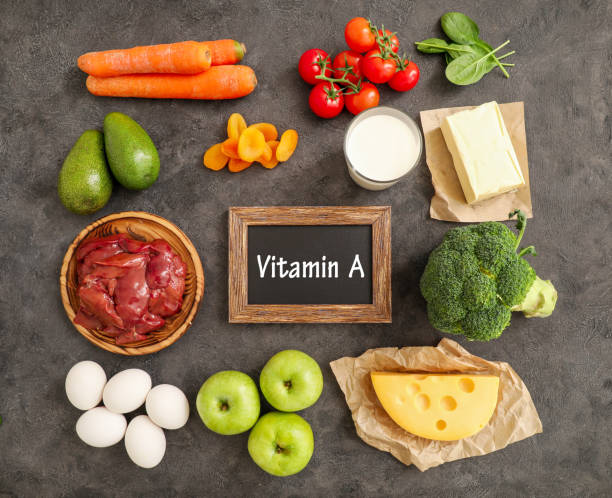Make an Appointment
Vitamin A refers to
retinol and retinyl esters
, which are fat-soluble retinoids. Vitamin A is necessary for immunological function, cellular communication, growth and development, as well as male and female reproduction. It promotes cell growth and differentiation and is essential for the optimal development and maintenance of the heart, lungs, eyes, and other organs. The best sources of Vitamin A are the food items that are a part of the daily diet. Vitamin A is particularly significant for vision because it is a component of rhodopsin, the light-sensitive protein in the retina that responds to light entering the eye. Also, it helps the conjunctival membranes and cornea differentiate and operate effectively.
The human diet contains two types of vitamin A: preformed vitamin A (retinol and retinyl esters) and provitamin A carotenoids. Animal-based foods, such as dairy products, eggs, salmon, and organ meats, contain preformed vitamin A. Plant pigments called provitamin A carotenoids are converted into vitamin A by the body in the intestine. Some of the best sources of Vitamin A are as follows:
Sweet potato
One entire roasted sweet potato has 1,403 mcg of vitamin A, which is 156 per cent of the daily value (Daily Value). This root vegetable contains beta carotene, a kind of vitamin A. According to a study, this chemical may help protect against age-related macular degeneration (AMD). According to some research, beta carotene may help protect against cancers like prostate cancer, although the results are mixed.
Carrots
Beta carotene is abundant in carrots. A half-cup of raw carrots contains 459 mcg of vitamin A or 51% of the daily value. A big carrot contains around 29 calories. This is a light and healthful snack when served with hummus or guacamole. Carrots are also high in dietary fibre, which can aid in constipation prevention and intestinal health.
Spinach
Spinach, like other leafy green vegetables, is high in nutrients. A half-cup of boiling spinach contains 573 mcg of vitamin A or 64% of the daily value. This serving also contains 17% of the daily value for iron and 19% of the daily value for magnesium. Magnesium is involved in over 300 bodily functions. According to several studies, spinach can help decrease blood pressure and enhance heart health.
Broccoli
Broccoli is another good source of vitamin A, with a half-cup containing 60 micrograms, or 7% of a person’s daily value. Broccoli is low in calories and high in vitamin C and K. Half a cup contains only 15 calories. Consuming cruciferous vegetables like broccoli may reduce a person’s risk of developing certain cancers due to the presence of a chemical called sulforaphane.
Mango
A whole raw mango has 112 mcg of vitamin A, which is around 12% of the daily value. Mangoes are high in antioxidants and dietary fibre, which benefit gut health and blood sugar regulation. This fruit is tasty on its own, but it is also great in a tropical fruit salad or mango salsa.


2 Comments
Pingback: Best Sources of Vitamin A – Sujata Birla Hospital
Pingback: What does healthy eating mean? | Yash Birla Healthcare